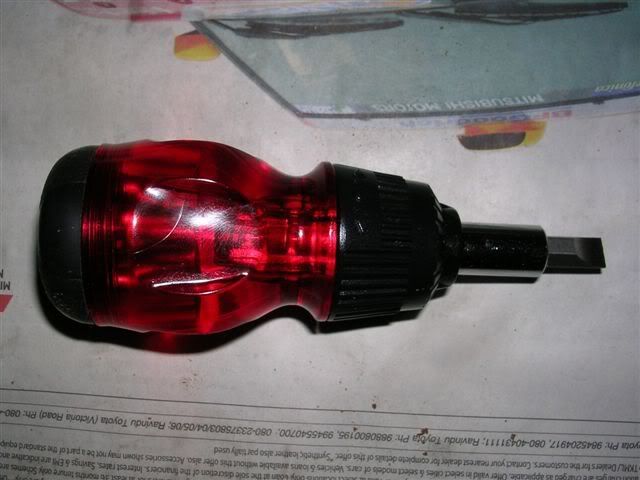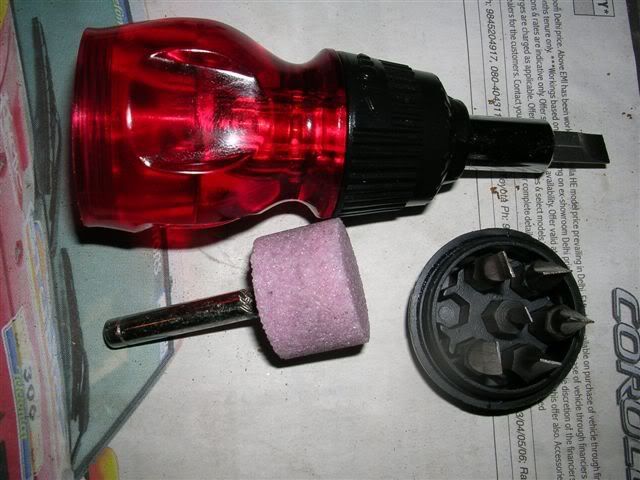How to give your stock a BASIC oil finish
Posted: Fri Mar 16, 2007 3:09 pm
I stress on the word basic as this is an art form and I am a long way from being proficient. However, mines an old stock and could do with a bit of nurturing and tarting up.
1) Remove all the metal bits and butt plate/pad if any as we are going to use a paint/polish stripper to remove as much of the old finish as possible without resorting to sand paper. Make sure you have a pair of rubber gloves at hand and use them!

2) Apply the paint stripper with a brush, leave for five minutes and then start rubbing it off the stock with a cloth before it dries.
In the pic below you can compare the stripped butt stock to the untouched fore-end.

Keep a toothbrush at hand to remove the stripper from the chequering and if any gets into the inletting remove that as well.
3) Once the stripper has removed whatever it is capable of (this particular one was close to useless but I could not find the one I usually use), it is time to clean out all the gunk from the inletting and get sanding.
4) Some tips regarding sanding:
a) Always sand in the direction of the grain and never across.
b) Put back the butt plate/pad and any metal parts the stock has been inletted for. I wouldn't bother putting in the action of a bolt action rifle or an air-rifle though. This is to ensure that you do not round the edges. However, please be careful and try not to sand the metal parts. If you find this difficult, put masking tape along the edges of the metal parts. Ditto for the chequering.
c) Cut the sand paper using a scissor rather than just tearing it with your hands. Make the cut/s so that it neatly folds or rolls around a sanding block.
d) Use a sanding block rather than just your fingers. This will ensure an even sanding rather than a wave like pattern. In this case I am going to use an eraser as it provides a level surface but can always bend a bit along the contours of the stock. Basically, the sanding block must have the shape and sometimes the dimension of the surface to be sanded. For example, if you wanted to sand the barrel channel, then you would use a pipe with a circular cross-section and of the appropriate diameter.
e) Keep a toothbrush to hand to keep the chequering clean.
f) Use the same toothbrush to remove excessive sawdust from the sandpaper. I use 3M Wet or Dry which are expensive.
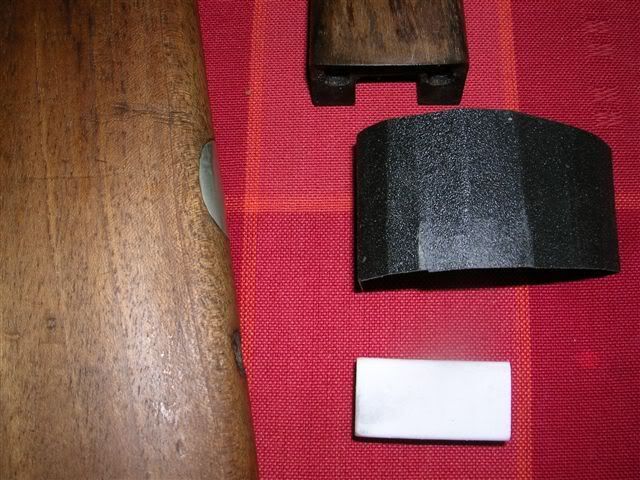
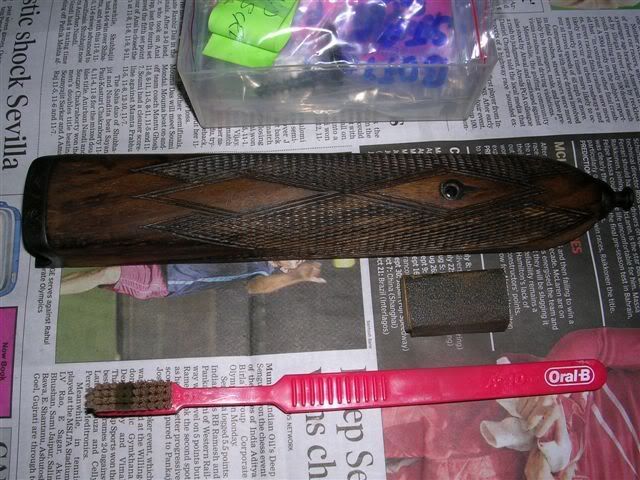
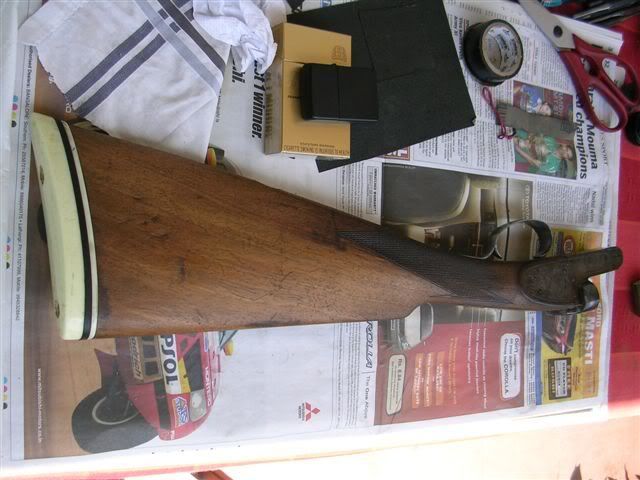
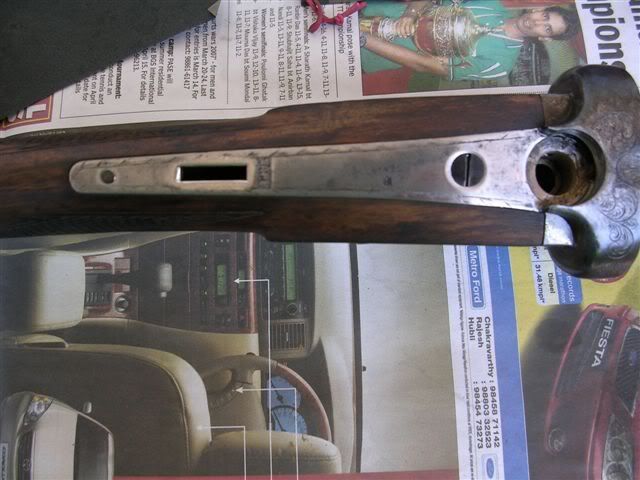
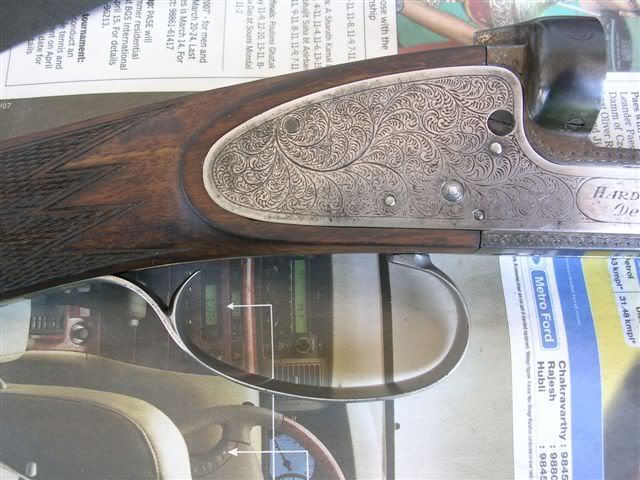
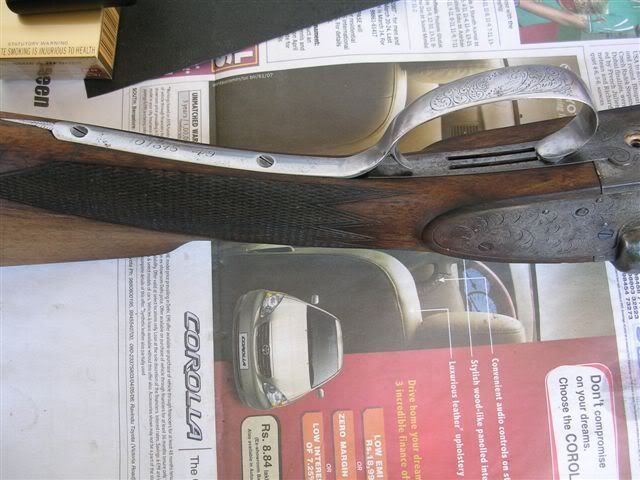
Continued on 18.3.2007:
Sanding was started at 150 grit, however, the pressure applied was moderate. Before changing to a higher grit, I clean off the saw dust with toothbrush and tissue paper and then wipe a damp (not sopping wet) cloth over the stock. One pass of the damp cloth is all that is required. Let dry. This is done to raise the loose fibres that were pressed down whilst sanding and will subsequently be sanded off the with the next highest grit.
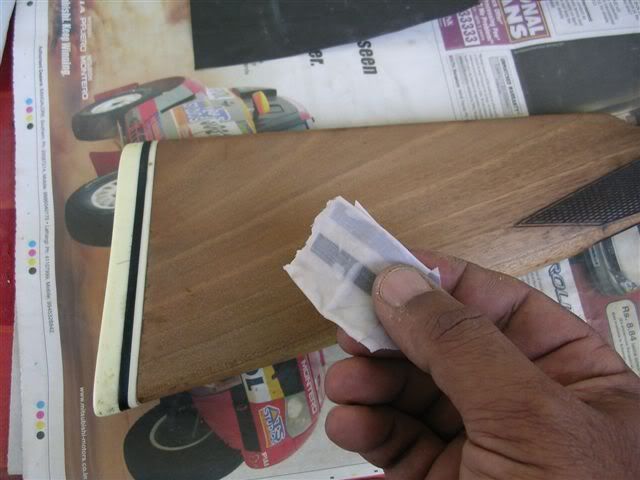
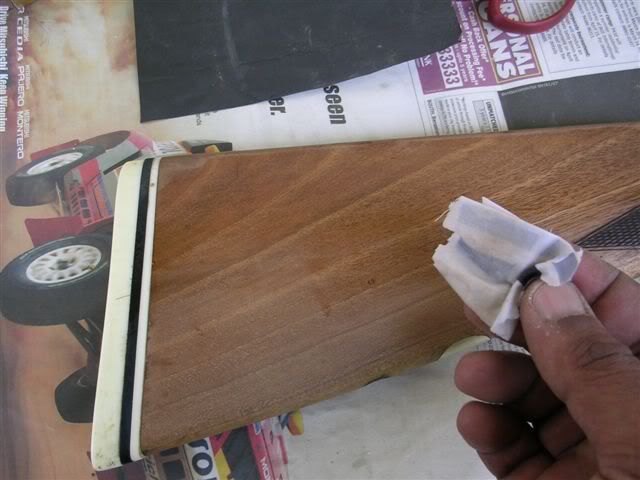
4) Raising dents: To raise a dent on the stock put a damp cloth over the dent/s and then apply light pressure over that particular point with a hot iron - preferably just the tip of the iron (what you see in the pics is a bit too much 'iron' and definitely wrong). Keep doing this until the dent raises.

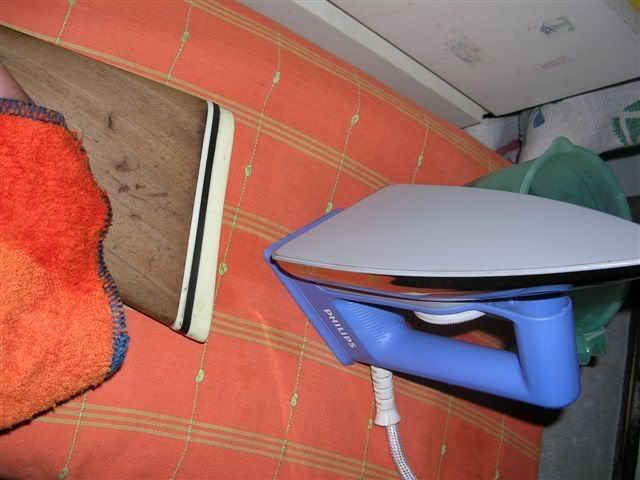
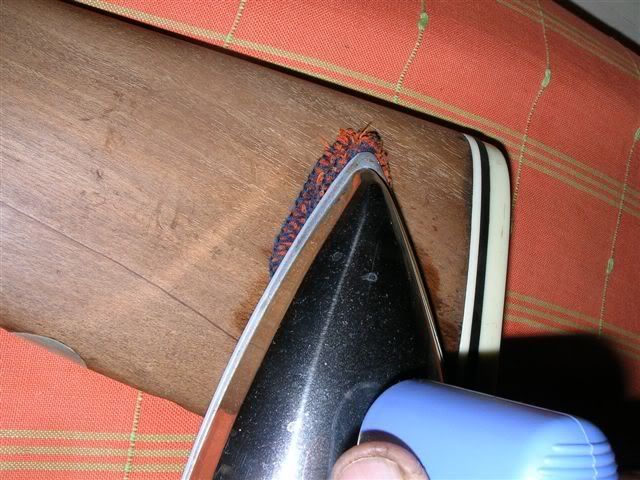

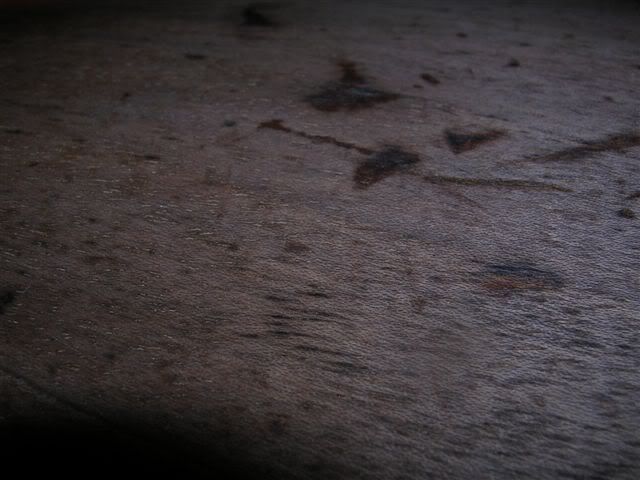
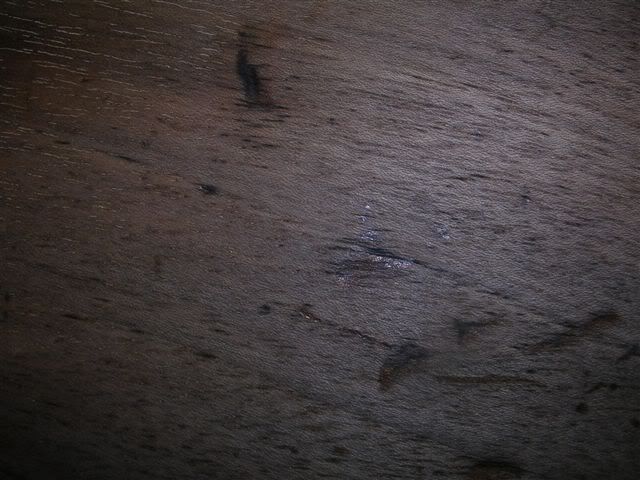
As you start sanding with finer grits (I am currently on 1000), the stock will acquire a sheen of its own and the smoothness should easily surpass that of glass.
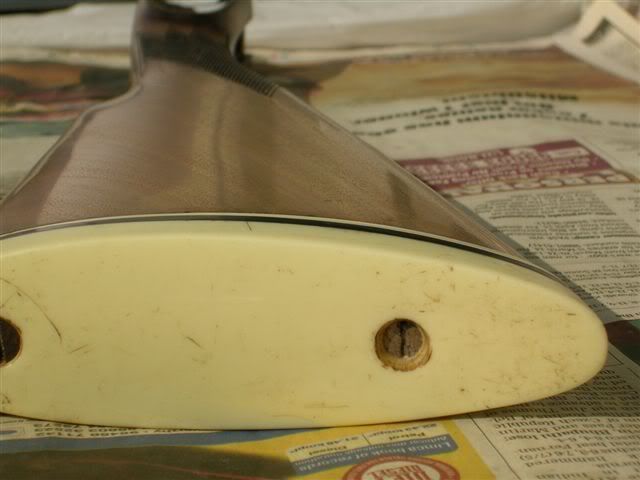
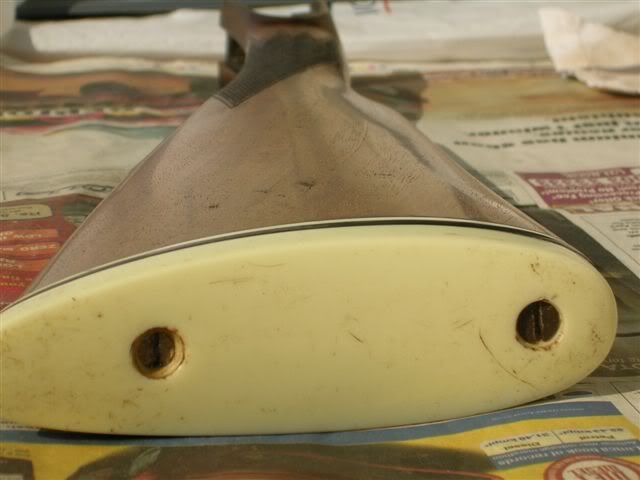
I have also been raising the dents on the butt stock between sanding sessions and the majority has been raised and only the darkish marks remain.
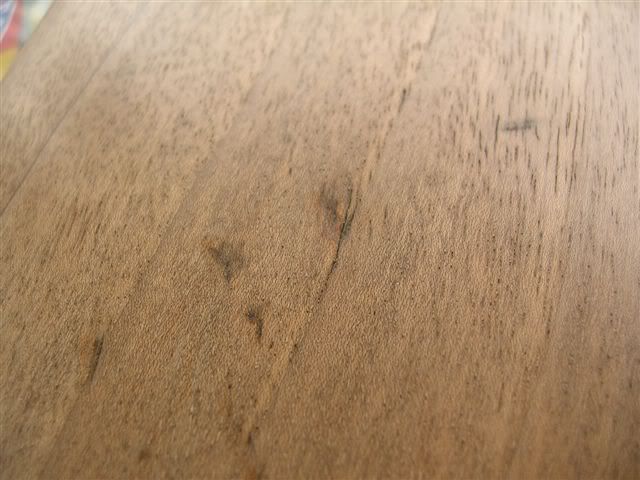
Once the stock has been sanded down, remove all the bits including the butt plate/pad.
Clean the stock thoroughly as well as the workplace and your hands.
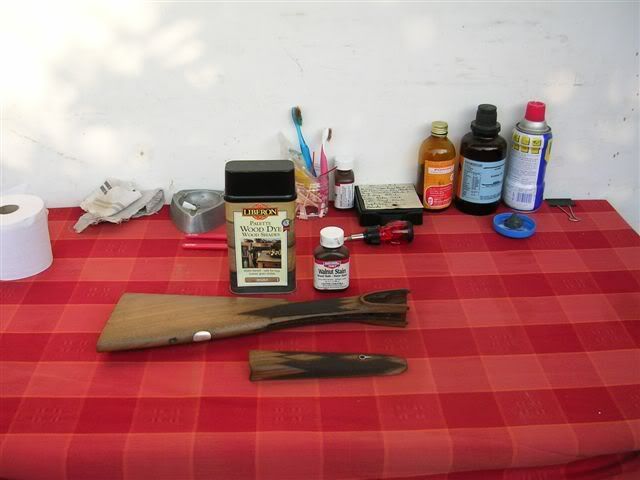
Choose your stain. I have decided on Birchwood Casey's water based walnut stain as I would like to finish off what little was left.
Pour some stain into a dixie cup and make a 'rubber' from a clean lint free bit of cloth.
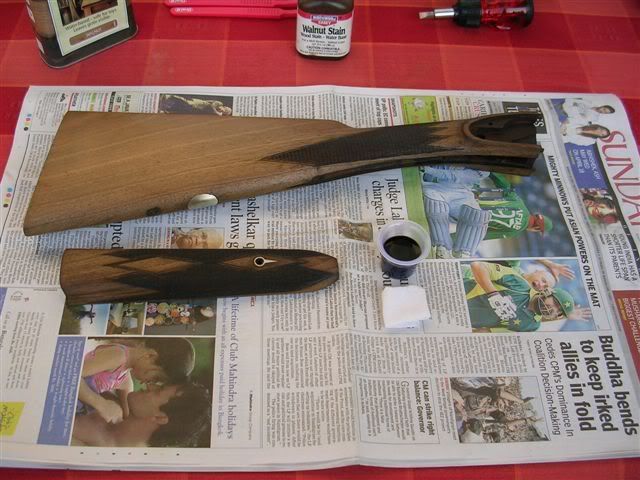
Apply evenly on stock....
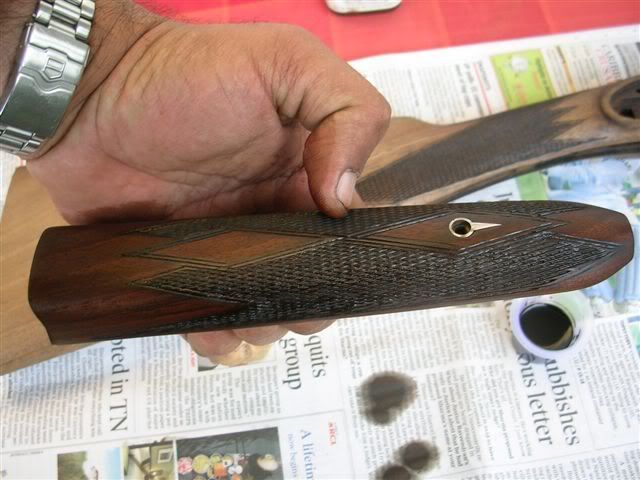
and let dry overnight.
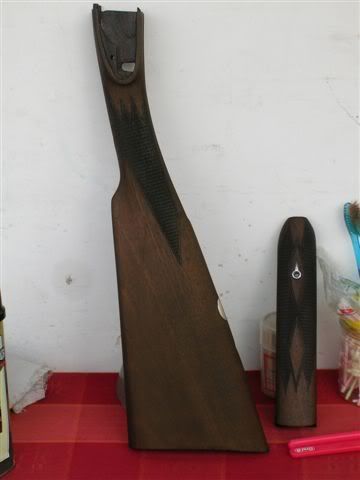
Once dry, rub/polish the stock with tissue paper or a clean cloth along the grain. Don't be too vigorous. In case, you need to darken the stock some more then apply the stain as mentioned above. However, if you should wish to lighten the colour then you could take a clean wet sponge or cloth to remove the degree of colour as required. Remember to let it dry overnight.
One thing I must mention is that it is not necessary to stain a stock. If the bare wood has a colour that pleases you then you could skip staining and go directly to oiling the stock. To see what it would like with just the oil finish, wipe a damp cloth over the wood. This will give you an approximate idea of how much the finish would darken if you left out the stain.
Continued on 19.3.2007:
This morning the fore-end and butt stock were rubbed down first with kitchen roll paper and followed by a clean cloth.
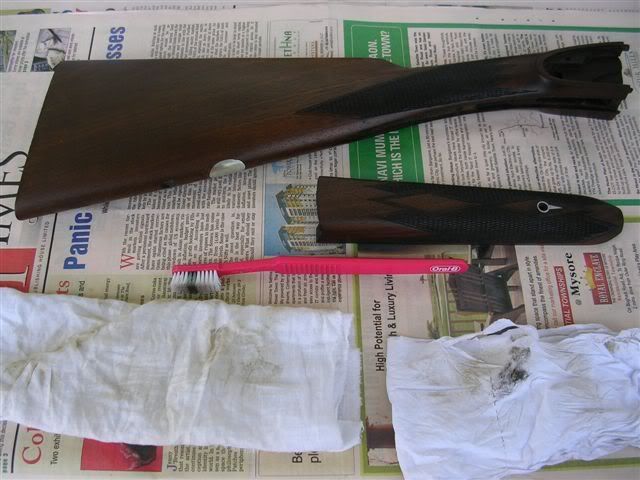
I felt the shade of brown on the rear of the buttstock was a bit dark, so used the method mentioned above to lighten it. This is one of the advantage of using a water based stain. Make sure you wipe the wet and dry cloths along the direction of the grain and use that dry cloth as soon as possible.
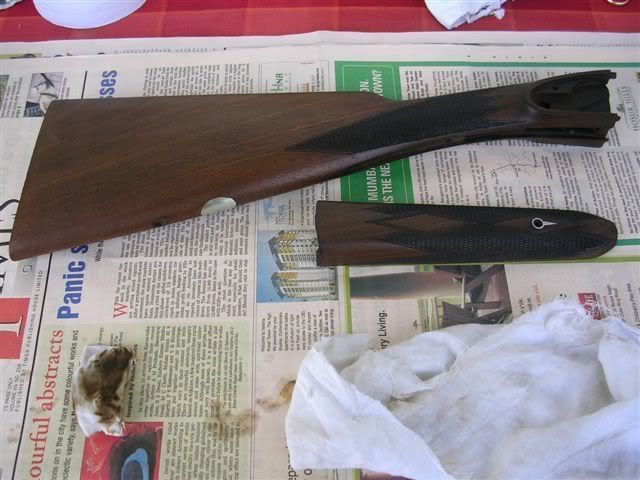
The wood was left to dry for a few hours indoors after which it was time to seal the inletted wood and rear of the stock using Birchwood Casey's Sealer and Filler. The reason for sealing these parts is because they seldom get a protective coat and hence act as a gateway for the ingress of moisture into the wood.
Pour some sealer into a dixie cup and then use a cotton ear bud, brush or just a cloth 'rubber' to apply it where required. It can also be put on the exposed surface of the stock but I am still debating whether to do so or not. I have done finishes with and without the sealer on the exposed wood and both come out well.
Apply liberally but don't leave excess behind. Once done, let the work stand until it has dried.
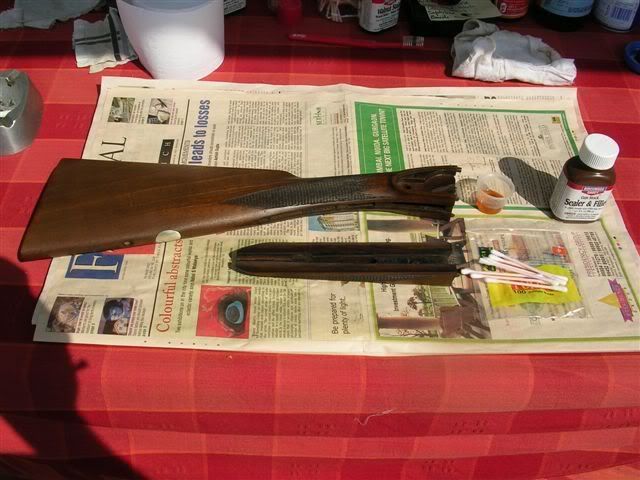
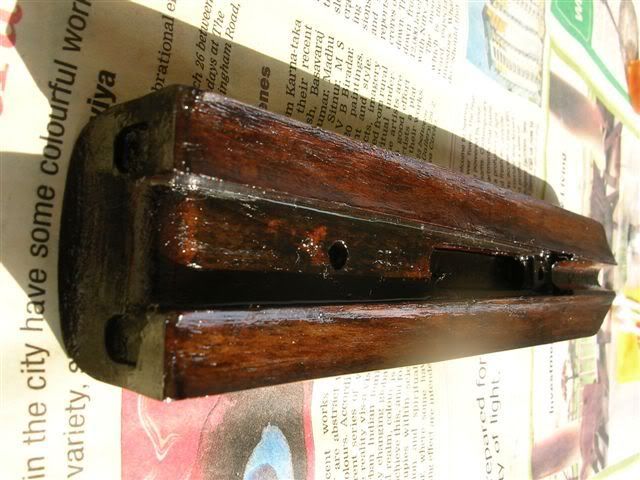
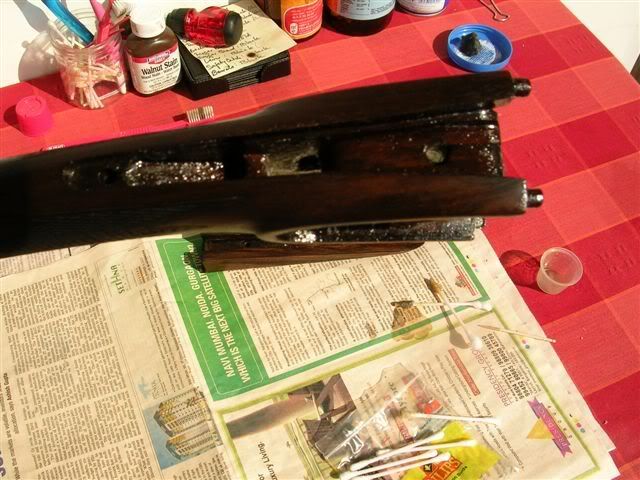
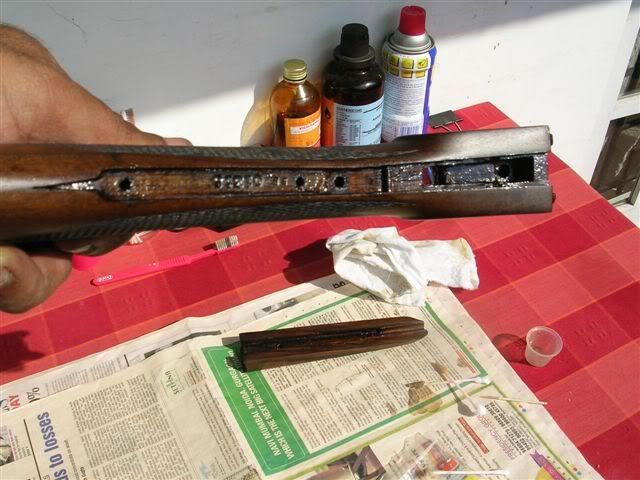
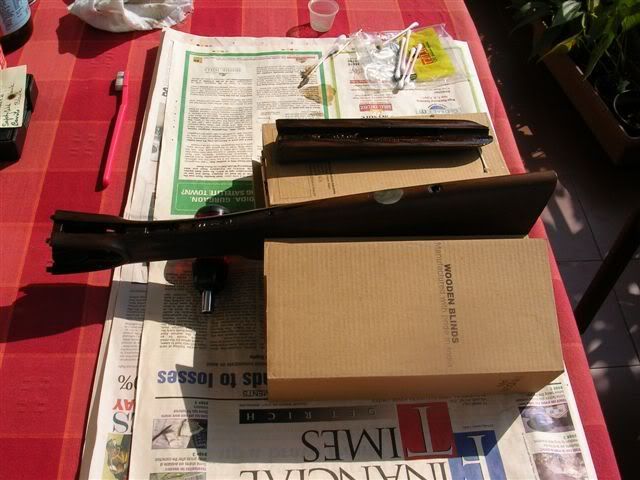
Continued on 20.3.2007:
Today we finally start applying the oil finish. This is applied in several coats. Between each coat the oil must be permitted to dry completely before applying the next.
I will be using Birchwood Casey's Tru Oil.
A few points to keep in mind:
a) Keep the work area clean and dust free.
b) Clean the wood work and rub it down with a clean dry cloth to get rid of finger prints before applying oil. Use a clean toothbrush to ensure the chequering is dust free.
c) Use your finger tip or a 'rubber' to apply the oil and keep rubbing it in until it starts feeling warm / hot. I use my index finger and the ball of my palm. Expect to get blisters from the friction.
d) Rub in the direction of the grain. Some people use a circular motion.
e) Pour some oil into a clean dixie cup and keep the main oil bottle covered at all other times as the oil tends to develop a skin and you do not want to waste something that is not available in India. If there is any surplus oil in the dixie cup after you finish, cover it with cling film.
f) This is very important. Before you apply the oil make sure you have a clean dust free place in which the work can be kept to dry and also decide beforehand how you will stand or suspend the wood work without the oiled parts touching anything.
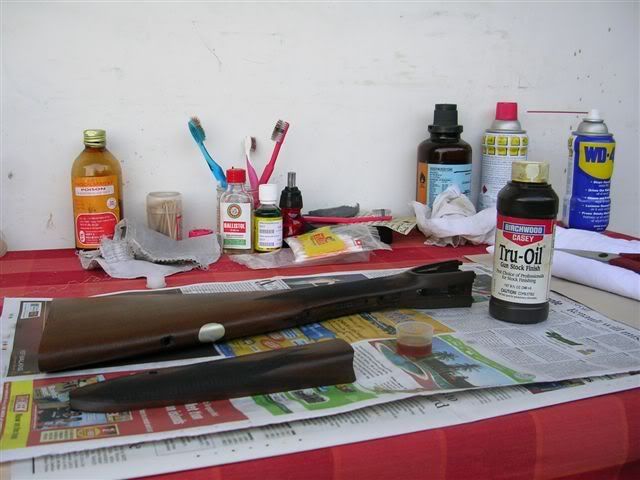
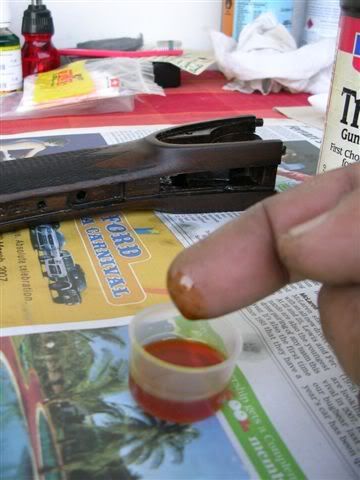
Here's the fore-end with its first coat of oil.
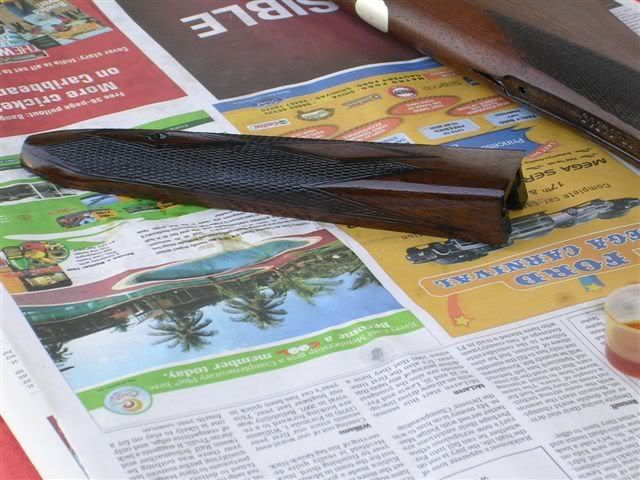
Here's a pic showing the butt stock with its first coat of oil. It's not as dark as it appears in the pic and we will turn that horrid gloss into a satin finish later.
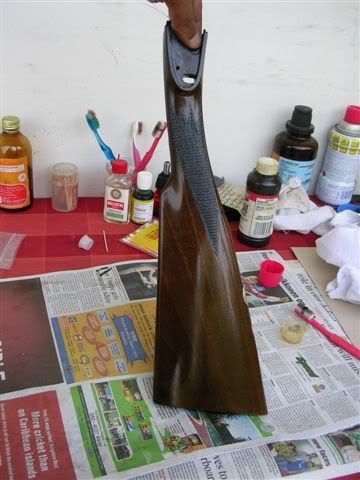
Next is a bad pic but I think it will give you an idea of how and where to suspend the stock whilst it dries.
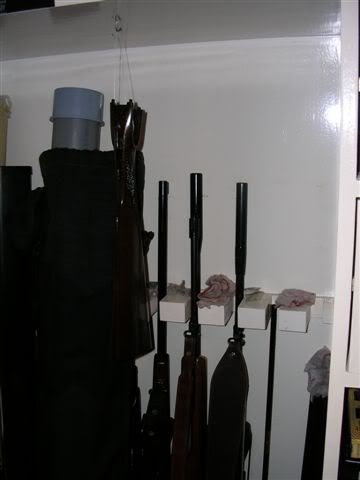
BTW, this Tru Oil is a bit sticky. However, once you have finished applying a coat of oil don't wash your hands with soap and water, as that will make it worse. Instead use a rag or kitchen towel to do the needful and then wash after 30 minutes or so.
Continued on 21.3.2007:
It has become humid and as a result of which the oil is taking 24 hours or a little more to dry.
The following pic shows the butt stock after it's first oil finish was cut back using 0000 grade wire wool and the fore-end with it's second coat of oil.
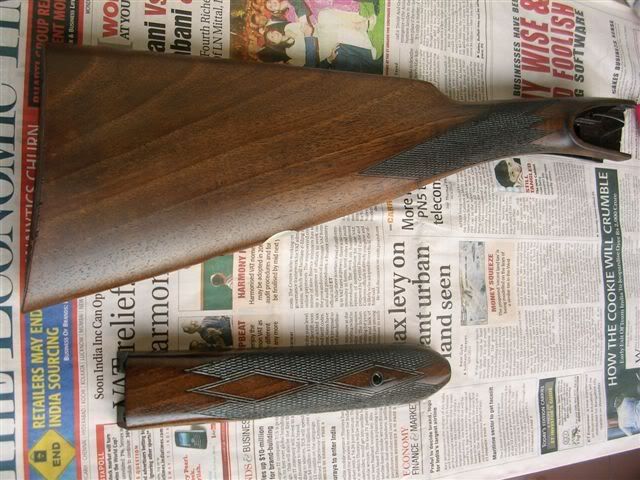
Continued on 23.3.2007:
The butt stock and fore-end are on their third and fourth coats respectively.
Before starting on the third coat, I decided to trim the butt plate received on the 21st as it wasn't an exact fit and neither were the holes in the plate and stock aligning.
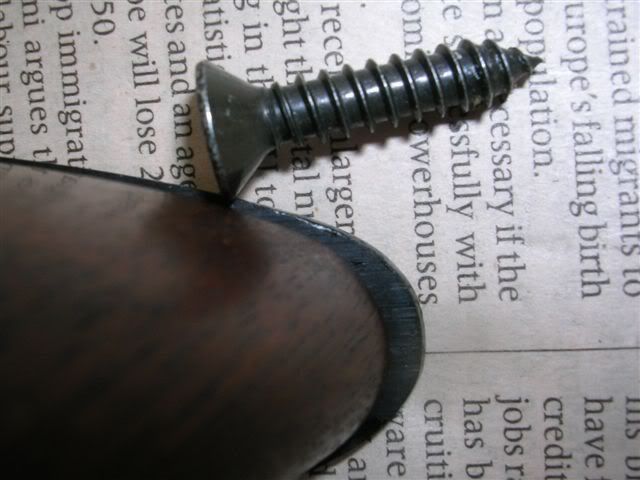
I decided not to alter the position of the hole near the heel as the plate was protruding by no more than a couple of millimetres. The excess was to be ground / filed off. The screws seen are not original but they were more or less the right size and the only one's I had at hand. It would have been nice if they were slotted headed screws in keeping with the guns vintage.
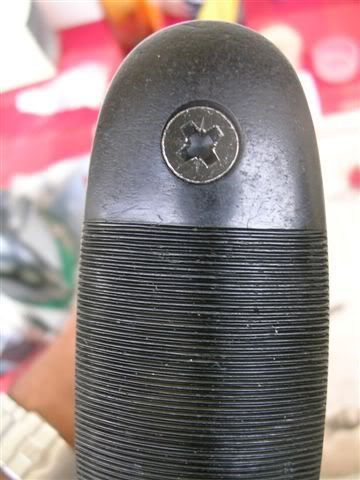
Before I could drill a new hole for the screw in the toe region, I had to fill in the existing hole.

Take a wooden dowel and whittle it to an approximate diameter, then use sandpaper to finish. Catch the end that is to be inserted with the sandpaper and then rotate the dowel as if sharpening a pencil.
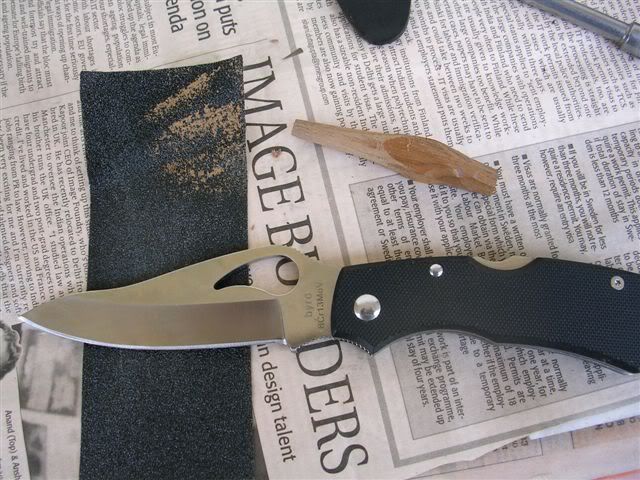
Clean out the existing hole and check for fit.
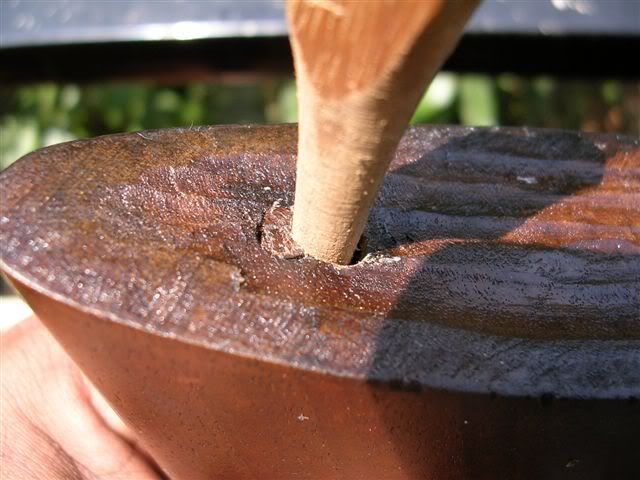
Put a couple of drops of glue into the hole and push the dowel in. Use a mallet to lightly tap it in as well.


Then use the mallet to break off the balance. Oops! this one broke a little short.

Put the plate back on and using a smaller drill bit, drill through the centre of the plate's hole. This is the pilot hole. Then go one size bigger until you reach the right size. Once done, screw down the wood screw.
Now file/grind of the excess plate material. It would be advisable to mask the end of the stock with masking tape lest you make a mistake and damage the finish.
Once your last coat of oil has dried, you have three options:
1) Rub the stock down with a polishing cloth and assemble the gun.
2) Same as No.1 above but wax and buff the stock before assembling the gun.
3) Use 0000 grade wire wool or Birchwood Casey's Stock Sheen & Conditioner to cut down on the gloss. Follow this up with a wax and buff before assembling the gun.
The following pictures show option No.3 being employed.

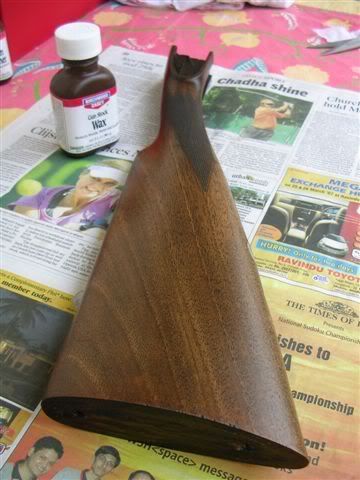
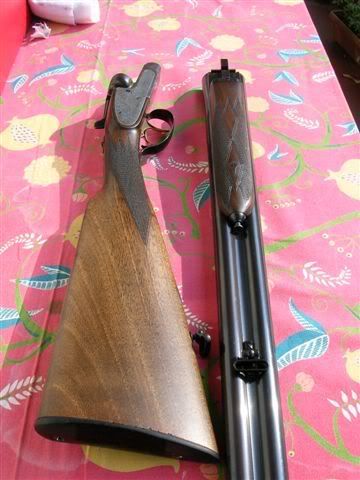

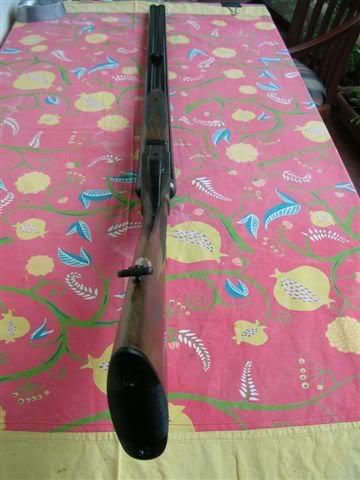

Mack The Knife
1) Remove all the metal bits and butt plate/pad if any as we are going to use a paint/polish stripper to remove as much of the old finish as possible without resorting to sand paper. Make sure you have a pair of rubber gloves at hand and use them!

2) Apply the paint stripper with a brush, leave for five minutes and then start rubbing it off the stock with a cloth before it dries.
In the pic below you can compare the stripped butt stock to the untouched fore-end.

Keep a toothbrush at hand to remove the stripper from the chequering and if any gets into the inletting remove that as well.
3) Once the stripper has removed whatever it is capable of (this particular one was close to useless but I could not find the one I usually use), it is time to clean out all the gunk from the inletting and get sanding.
4) Some tips regarding sanding:
a) Always sand in the direction of the grain and never across.
b) Put back the butt plate/pad and any metal parts the stock has been inletted for. I wouldn't bother putting in the action of a bolt action rifle or an air-rifle though. This is to ensure that you do not round the edges. However, please be careful and try not to sand the metal parts. If you find this difficult, put masking tape along the edges of the metal parts. Ditto for the chequering.
c) Cut the sand paper using a scissor rather than just tearing it with your hands. Make the cut/s so that it neatly folds or rolls around a sanding block.
d) Use a sanding block rather than just your fingers. This will ensure an even sanding rather than a wave like pattern. In this case I am going to use an eraser as it provides a level surface but can always bend a bit along the contours of the stock. Basically, the sanding block must have the shape and sometimes the dimension of the surface to be sanded. For example, if you wanted to sand the barrel channel, then you would use a pipe with a circular cross-section and of the appropriate diameter.
e) Keep a toothbrush to hand to keep the chequering clean.
f) Use the same toothbrush to remove excessive sawdust from the sandpaper. I use 3M Wet or Dry which are expensive.






Continued on 18.3.2007:
Sanding was started at 150 grit, however, the pressure applied was moderate. Before changing to a higher grit, I clean off the saw dust with toothbrush and tissue paper and then wipe a damp (not sopping wet) cloth over the stock. One pass of the damp cloth is all that is required. Let dry. This is done to raise the loose fibres that were pressed down whilst sanding and will subsequently be sanded off the with the next highest grit.


4) Raising dents: To raise a dent on the stock put a damp cloth over the dent/s and then apply light pressure over that particular point with a hot iron - preferably just the tip of the iron (what you see in the pics is a bit too much 'iron' and definitely wrong). Keep doing this until the dent raises.






As you start sanding with finer grits (I am currently on 1000), the stock will acquire a sheen of its own and the smoothness should easily surpass that of glass.


I have also been raising the dents on the butt stock between sanding sessions and the majority has been raised and only the darkish marks remain.

Once the stock has been sanded down, remove all the bits including the butt plate/pad.
Clean the stock thoroughly as well as the workplace and your hands.

Choose your stain. I have decided on Birchwood Casey's water based walnut stain as I would like to finish off what little was left.
Pour some stain into a dixie cup and make a 'rubber' from a clean lint free bit of cloth.

Apply evenly on stock....

and let dry overnight.

Once dry, rub/polish the stock with tissue paper or a clean cloth along the grain. Don't be too vigorous. In case, you need to darken the stock some more then apply the stain as mentioned above. However, if you should wish to lighten the colour then you could take a clean wet sponge or cloth to remove the degree of colour as required. Remember to let it dry overnight.
One thing I must mention is that it is not necessary to stain a stock. If the bare wood has a colour that pleases you then you could skip staining and go directly to oiling the stock. To see what it would like with just the oil finish, wipe a damp cloth over the wood. This will give you an approximate idea of how much the finish would darken if you left out the stain.
Continued on 19.3.2007:
This morning the fore-end and butt stock were rubbed down first with kitchen roll paper and followed by a clean cloth.

I felt the shade of brown on the rear of the buttstock was a bit dark, so used the method mentioned above to lighten it. This is one of the advantage of using a water based stain. Make sure you wipe the wet and dry cloths along the direction of the grain and use that dry cloth as soon as possible.

The wood was left to dry for a few hours indoors after which it was time to seal the inletted wood and rear of the stock using Birchwood Casey's Sealer and Filler. The reason for sealing these parts is because they seldom get a protective coat and hence act as a gateway for the ingress of moisture into the wood.
Pour some sealer into a dixie cup and then use a cotton ear bud, brush or just a cloth 'rubber' to apply it where required. It can also be put on the exposed surface of the stock but I am still debating whether to do so or not. I have done finishes with and without the sealer on the exposed wood and both come out well.
Apply liberally but don't leave excess behind. Once done, let the work stand until it has dried.





Continued on 20.3.2007:
Today we finally start applying the oil finish. This is applied in several coats. Between each coat the oil must be permitted to dry completely before applying the next.
I will be using Birchwood Casey's Tru Oil.
A few points to keep in mind:
a) Keep the work area clean and dust free.
b) Clean the wood work and rub it down with a clean dry cloth to get rid of finger prints before applying oil. Use a clean toothbrush to ensure the chequering is dust free.
c) Use your finger tip or a 'rubber' to apply the oil and keep rubbing it in until it starts feeling warm / hot. I use my index finger and the ball of my palm. Expect to get blisters from the friction.
d) Rub in the direction of the grain. Some people use a circular motion.
e) Pour some oil into a clean dixie cup and keep the main oil bottle covered at all other times as the oil tends to develop a skin and you do not want to waste something that is not available in India. If there is any surplus oil in the dixie cup after you finish, cover it with cling film.
f) This is very important. Before you apply the oil make sure you have a clean dust free place in which the work can be kept to dry and also decide beforehand how you will stand or suspend the wood work without the oiled parts touching anything.


Here's the fore-end with its first coat of oil.

Here's a pic showing the butt stock with its first coat of oil. It's not as dark as it appears in the pic and we will turn that horrid gloss into a satin finish later.

Next is a bad pic but I think it will give you an idea of how and where to suspend the stock whilst it dries.

BTW, this Tru Oil is a bit sticky. However, once you have finished applying a coat of oil don't wash your hands with soap and water, as that will make it worse. Instead use a rag or kitchen towel to do the needful and then wash after 30 minutes or so.
Continued on 21.3.2007:
It has become humid and as a result of which the oil is taking 24 hours or a little more to dry.
The following pic shows the butt stock after it's first oil finish was cut back using 0000 grade wire wool and the fore-end with it's second coat of oil.

Continued on 23.3.2007:
The butt stock and fore-end are on their third and fourth coats respectively.
Before starting on the third coat, I decided to trim the butt plate received on the 21st as it wasn't an exact fit and neither were the holes in the plate and stock aligning.

I decided not to alter the position of the hole near the heel as the plate was protruding by no more than a couple of millimetres. The excess was to be ground / filed off. The screws seen are not original but they were more or less the right size and the only one's I had at hand. It would have been nice if they were slotted headed screws in keeping with the guns vintage.

Before I could drill a new hole for the screw in the toe region, I had to fill in the existing hole.

Take a wooden dowel and whittle it to an approximate diameter, then use sandpaper to finish. Catch the end that is to be inserted with the sandpaper and then rotate the dowel as if sharpening a pencil.

Clean out the existing hole and check for fit.

Put a couple of drops of glue into the hole and push the dowel in. Use a mallet to lightly tap it in as well.


Then use the mallet to break off the balance. Oops! this one broke a little short.

Put the plate back on and using a smaller drill bit, drill through the centre of the plate's hole. This is the pilot hole. Then go one size bigger until you reach the right size. Once done, screw down the wood screw.
Now file/grind of the excess plate material. It would be advisable to mask the end of the stock with masking tape lest you make a mistake and damage the finish.
Once your last coat of oil has dried, you have three options:
1) Rub the stock down with a polishing cloth and assemble the gun.
2) Same as No.1 above but wax and buff the stock before assembling the gun.
3) Use 0000 grade wire wool or Birchwood Casey's Stock Sheen & Conditioner to cut down on the gloss. Follow this up with a wax and buff before assembling the gun.
The following pictures show option No.3 being employed.






Mack The Knife
